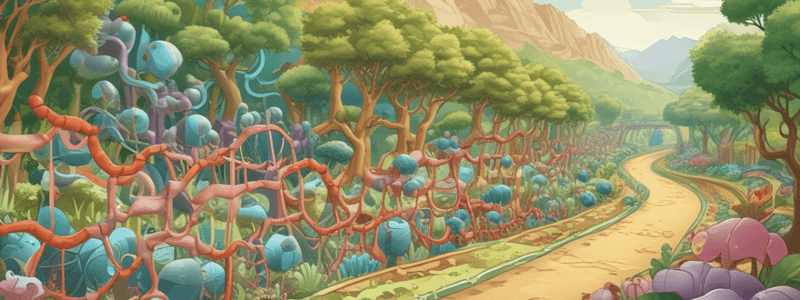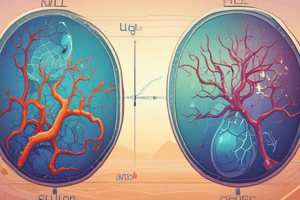Podcast
Questions and Answers
Which pathway leads to the production of lactate from pyruvate?
Which pathway leads to the production of lactate from pyruvate?
- Pentose phosphate pathway
- Gluconeogenesis
- Anaerobic respiration (correct)
- Citric Acid Cycle
What is the end product of glycolysis?
What is the end product of glycolysis?
- Pyruvate (correct)
- Ribose 5-phosphate
- Glucose
- ATP
Which process involves the synthesis of structural polymers?
Which process involves the synthesis of structural polymers?
- Extracellular matrix (correct)
- Pentose phosphate pathway
- Citric Acid Cycle
- Glycolysis
Which pathway is directly associated with the production of ATP through the Electron Transport Chain?
Which pathway is directly associated with the production of ATP through the Electron Transport Chain?
In which pathway is ribose 5-phosphate produced?
In which pathway is ribose 5-phosphate produced?
Which molecule does glycolysis start with in the preparatory phase?
Which molecule does glycolysis start with in the preparatory phase?
What is produced alongside ATP in the pay-off phase from DHAP?
What is produced alongside ATP in the pay-off phase from DHAP?
Which of the following is NOT an intermediate in the preparatory phase of glycolysis?
Which of the following is NOT an intermediate in the preparatory phase of glycolysis?
How many ATP molecules are consumed in the preparatory phase?
How many ATP molecules are consumed in the preparatory phase?
What is the final product of the pay-off phase of glycolysis?
What is the final product of the pay-off phase of glycolysis?
What does the breakdown of carbohydrate, fat, and protein produce?
What does the breakdown of carbohydrate, fat, and protein produce?
What is required for anabolic processes?
What is required for anabolic processes?
What can metabolism be identified as?
What can metabolism be identified as?
What is the primary function of catabolic processes?
What is the primary function of catabolic processes?
What is the role of ATP in anabolic processes?
What is the role of ATP in anabolic processes?
Which process involves the synthesis of glycogen from glucose?
Which process involves the synthesis of glycogen from glucose?
What is the main product of glycolysis?
What is the main product of glycolysis?
Which pathway generates glucose from non-carbohydrate sources?
Which pathway generates glucose from non-carbohydrate sources?
What does the pentose phosphate pathway produce?
What does the pentose phosphate pathway produce?
What is ribose 5-phosphate a product of?
What is ribose 5-phosphate a product of?
During anaerobic respiration, what is pyruvate converted into?
During anaerobic respiration, what is pyruvate converted into?
Which process is associated with the production of NADH, FADH2, and CO2?
Which process is associated with the production of NADH, FADH2, and CO2?
Which molecule does the electron transport chain use to produce ATP?
Which molecule does the electron transport chain use to produce ATP?
Which pathway involves the synthesis of structural polymers?
Which pathway involves the synthesis of structural polymers?
What is the direct product of anaerobic respiration of pyruvate?
What is the direct product of anaerobic respiration of pyruvate?
Which of the following is NOT a fate of glucose?
Which of the following is NOT a fate of glucose?
Which compound is directly involved in the Electron Transport Chain?
Which compound is directly involved in the Electron Transport Chain?
What process leads to the production of Ribose 5-phosphate?
What process leads to the production of Ribose 5-phosphate?
Why is a phosphate group negatively charged?
Why is a phosphate group negatively charged?
What is one function of adding a phosphate group to a molecule?
What is one function of adding a phosphate group to a molecule?
Which of the following is represented by the chemical formula $HO-P-O-_O^-$?
Which of the following is represented by the chemical formula $HO-P-O-_O^-$?
In what way can a phosphate group help in biochemical reactions?
In what way can a phosphate group help in biochemical reactions?
Why might a phosphate group be targeted by a positively-charged enzyme or co-factor?
Why might a phosphate group be targeted by a positively-charged enzyme or co-factor?
What process is directly involved in the breakdown of glucose for energy?
What process is directly involved in the breakdown of glucose for energy?
Which metabolic process involves the TCA cycle?
Which metabolic process involves the TCA cycle?
In which process is ATP primarily synthesized?
In which process is ATP primarily synthesized?
What is the primary role of ATP in metabolic processes?
What is the primary role of ATP in metabolic processes?
Which process is involved in the breakdown of fatty acids?
Which process is involved in the breakdown of fatty acids?
What is produced during glycolysis?
What is produced during glycolysis?
Which process involves the conversion of glucose into glycogen?
Which process involves the conversion of glucose into glycogen?
Which metabolic pathway involves the formation of glucose from non-carbohydrate sources?
Which metabolic pathway involves the formation of glucose from non-carbohydrate sources?
In anaerobic respiration, what compound is lactate eventually converted into before entering the electron transport chain?
In anaerobic respiration, what compound is lactate eventually converted into before entering the electron transport chain?
Which of the following pathways produces Ribose 5-phosphate?
Which of the following pathways produces Ribose 5-phosphate?
Which process directly converts glucose to glycogen?
Which process directly converts glucose to glycogen?
In which pathway is glucose converted to ribose 5-phosphate?
In which pathway is glucose converted to ribose 5-phosphate?
Which end product is formed from pyruvate during anaerobic respiration?
Which end product is formed from pyruvate during anaerobic respiration?
Which molecule directly enters the Citric Acid Cycle from proteins?
Which molecule directly enters the Citric Acid Cycle from proteins?
What is the primary product of pyruvate in the Citric Acid Cycle?
What is the primary product of pyruvate in the Citric Acid Cycle?
Flashcards
What is Glycolysis?
What is Glycolysis?
The breakdown of glucose to produce pyruvate, ATP, and NADH.
What is the location and oxygen requirement of Glycolysis?
What is the location and oxygen requirement of Glycolysis?
A metabolic process that occurs in the cytoplasm and does not require oxygen.
What is Glycogenesis?
What is Glycogenesis?
The process of glycogen synthesis that occurs when glucose levels are high.
What is Gluconeogenesis?
What is Gluconeogenesis?
Signup and view all the flashcards
What is the Pentose Phosphate Pathway?
What is the Pentose Phosphate Pathway?
Signup and view all the flashcards
What is Pyruvate?
What is Pyruvate?
Signup and view all the flashcards
What is Anaerobic Respiration?
What is Anaerobic Respiration?
Signup and view all the flashcards
What is the Citric Acid Cycle?
What is the Citric Acid Cycle?
Signup and view all the flashcards
What is the Electron Transport Chain?
What is the Electron Transport Chain?
Signup and view all the flashcards
Study Notes
Carbohydrate Metabolism
- Glucose is a central molecule in the body's energy production and biosynthesis processes
- Glucose can be involved in various pathways, including glycogenesis, glycolysis, and gluconeogenesis
Glycolysis
- Breakdown of glucose to produce pyruvate, ATP, and NADH
- Occurs in the cytoplasm and does not require oxygen (anaerobic)
- Produces 2 ATP and 2 NADH
Glycogenesis
- Process of glycogen synthesis that occurs when glucose levels are high
- Excess glucose is converted into glycogen for storage in liver and muscle
- Glycogen can be broken down to glucose when energy is needed
Gluconeogenesis
- Synthesis of glucose from non-carbohydrate sources, such as pyruvate
- Occurs in the liver and kidneys
- Essential for maintaining blood sugar levels during fasting or starvation
Pentose Phosphate Pathway
- Uses glucose to produce NADPH and pentoses, which are essential for biosynthesis
- Produces ribose 5-phosphate, which is necessary for nucleic acid synthesis
Pyruvate
- Produced from glycolysis
- Can be converted into lactate through anaerobic respiration
- Can be converted into CO2, NADH, and FADH2 through the citric acid cycle
- Can be converted into ATP through the electron transport chain
Anaerobic Respiration
- Conversion of pyruvate into lactate
- Occurs in the absence of oxygen
- Produces 2 ATP
Citric Acid Cycle
- Conversion of pyruvate into CO2, NADH, and FADH2
- Occurs in the mitochondria
- Produces 2 ATP, 6 NADH, and 2 FADH2
Electron Transport Chain
- Uses NADH and FADH2 to produce ATP
- Occurs in the mitochondria
- Produces 32-34 ATP
Extracellular Matrix
- Synthesis of structural polymers from glucose
- Essential for maintaining tissue structure and function
Fat and Protein Metabolism
- Fat can be converted into acetyl-CoA, which can enter the citric acid cycle
- Protein can be converted into acetyl-CoA, which can enter the citric acid cycle
- Fat and protein can be converted into glucose through gluconeogenesis
Studying That Suits You
Use AI to generate personalized quizzes and flashcards to suit your learning preferences.




